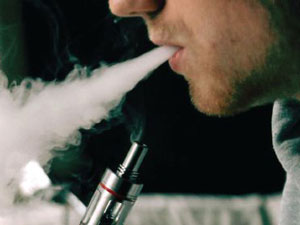Dangerious e-cigarette epidemic among youth,
By Nisa Islam Muhammad -Staff Writer- | Last updated: Jan 10, 2019 - 9:55:04 AMWhat's your opinion on this article?
The U.S. Surgeon General, Vice Admiral Jerome Adams, recently declared youth vaping (smoking electronic cigarettes) an epidemic. According to medicalnewstoday.com, e-cigarettes are battery-operated devices that emitdoses of vaporized nicotine, or non-nicotine solutions, for the user to inhale. It aims to provide a similar sensation to inhaling tobacco smoke, without the smoke.
“E-cigarette aerosol is not harmless. Most e-cigarettes contain nicotine—the addictive drug in regular cigarettes, cigars, and other tobacco products. Nicotine exposure during adolescence can harm the developing brain— which continues to develop until about age 25. Nicotine exposure during adolescence can impact learning, memory, and attention. Using nicotine in adolescence can also increase risk for future addiction to other drugs,” Vice Admiral Adams wrote in a rare advisory to the nation.

|
“Recently, a new type of e-cigarette has become increasingly popular among our nation’s youth due to its minimal exhaled aerosol, reduced odor, and small size, making it easy to conceal. Many of these new e-cigarettes look like a USB fl ash drive, among other shapes. One of the most commonly sold USB fl ash drive shaped e-cigarettes is JUUL, which experienced a 600% surge in sales during 2016-2017, giving it the greatest market share of any e-cigarette in the U.S. by the end of 2017.”
According to his advisory issued December 18, e-cigarettes entered the U.S. marketplace around 2007, and since 2014, has been the most commonly used tobacco product among U.S. youth. E-cigarette use among U.S. middle and high school students increased 900 percent during 2011-2015, before declining for the first time during 2015-2017.
However, current e-cigarette use increased 78 percent among high school students during the past year, from 11.7 percent in 2017 to 20.8 percent in 2018. In 2018, more than 3.6 million U.S. youth, including one in five high school students and one in 20 middle school students, currently use e-cigarettes.
Many e-cigarettes also come in “kid-friendly” flavors. In addition to making e-cigarettes more appealing to young people, some of the chemicals used to make certain flavors may also have health risks. E-cigarettes can also be used to inhale other drugs, including marijuana. In 2016, one-third of U.S. middle and high school students who ever used e-cigarettes had used marijuana in e-cigarettes.
Most of the marketing materials for JUUL and other e-cigarettes seem to target White suburban teens. That may be primarily because of the cost, e-cigarette kits range from $25 to $60, and refill cartridges range from $7 to $10. Black teens, however, are not immune to the lure and temptation.
“By the time I knew what my son was doing, he was addicted and had spent hundreds of dollars on e-cigarettes,” Tiandra Henderson of Bethesda, Maryland told The Final Call. “I had never heard of JUULs and wasn’t sure what they were. I saw the small containers but thought they were thumb drives. They are deceptively built. Parents need to be aware. I had to take charge of what my son was doing and who his friends were. I was on the lookout for drugs and drinking. That didn’t happen at all. Something more modern and sinister took their place,” she said.
The surgeon general’s advisory targets parents, teachers, health professionals and public health policy makers. It has no enforcement power behind it. It is merely a warning to the general public. The Food and Drug Administration (FDA) has enforcement power.
In September, the FDA announced the issuance of more than 1,300 warning letters and civil money penalty complaints to retailers who illegally sold JUUL and other e-cigarette products to minors.
The FDA has also requested information from JUUL, and several other manufacturers, related to marketing, youth appeal and product design, including details on the companies’ plans to address the problem of youth use of their products. —Nisa Islam Muhammad
INSIDE STORIES AND REVIEWS
-
-
About Harriett ... and the Negro Hollywood Road Show
By Rabiah Muhammad, Guest Columnist » Full Story -
Skepticism greets Jay-Z, NFL talk of inspiring change
By Bryan 18X Crawford and Richard B. Muhammad The Final Call Newspaper @TheFinalCall » Full Story -
The painful problem of Black girls and suicide
By Charlene Muhammad -National Correspondent- » Full Story -
Exploitation of Innocence - Report: Perceptions, policies hurting Black girls
By Charlene Muhammad -National Correspondent- » Full Story -
Big Ballin: Big ideas fuel a father’s Big Baller Brand and brash business sense
By Bryan Crawford -Contributing Writer- » Full Story






 Click Here Stay Connected!
Click Here Stay Connected!








